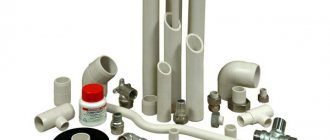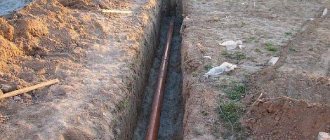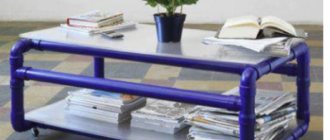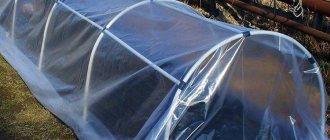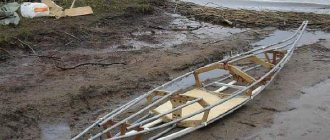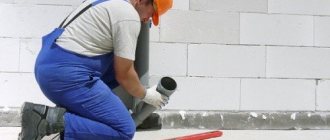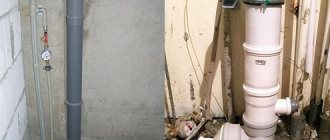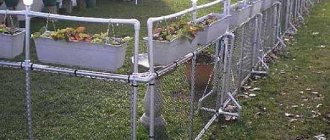The peculiarity of the drip irrigation system is that moisture supplied through a special polymer tape or droppers is delivered directly to the root system of plants. Thanks to this, the overall water consumption is reduced and at the same time the crop yield increases. In addition, drip irrigation does not lead to waterlogging of the soil and reduces the likelihood of weeds appearing - they do not receive enough moisture.
It’s not difficult to create a similar system in your own garden. This article will provide you with detailed step-by-step instructions for designing and installing drip irrigation using polypropylene pipes.
Do-it-yourself drip irrigation from polypropylene pipes
Polypropylene pipes - main characteristics
Compared to conventional metal pipes, polypropylene products have a set of advantages that make them a good choice for installing a drip irrigation system on a personal plot.
Polypropylene pipes
It is worth highlighting the following advantages of PP pipes:
- light weight;
- cheapness;
- ease of installation;
- no condensation;
- almost complete absence of deposits on the internal walls;
- service life is about 50 years.
Polypropylene pipes and fittings
In order to standardize characteristics, all polypropylene pipes are marked, dividing them into four groups.
- PN10 - pipes designed only for cold water (up to +45 degrees) and exclusively at pressures up to 10 atmospheres. Due to relatively weak characteristics they are rare.
- PN16 - pipes designed to operate at pressures up to 16 atmospheres and temperatures up to +60 degrees. Suitable for drip irrigation system.
- PN20 – maximum operating pressure is 20 atmospheres, can withstand temperatures up to +95 degrees.
- PN25 - the permissible temperature is similar to the previous type; the pressure in them can reach up to 25 atmospheres. They are equipped with reinforced layers that increase the strength of the pipe.
Designation of the main indicators on the pipe
Types of polypropylene pipes
In drip irrigation lines, the operating pressure does not exceed 2-3 atmospheres, and the water temperature is equal to or lower than the ambient air temperature. Therefore, polypropylene pipes PN10 and PN16 can be used here. The use of PN20 and PN25 is acceptable, but their characteristics are redundant for such a system.
Prices for polypropylene pipes
polypropylene pipes
Where and approximately at what cost are they sold?
Pipes for drip irrigation can be purchased at any organization that deals with water supply systems, a hardware store, or an online store.
Examples:
- HDPE pipe 32 mm. Price 50 rubles.
- HDPE pipe 25 mm. Price 40 rubles.
- HDPE pipe 16 mm. Price 30 rubles.
The price of HDPE pipes depends on its diameter.
Do-it-yourself drip irrigation - making a plan
This system consists of several elements; let’s get acquainted with the features of each of them.
- Water container . On one side it is connected to the drip irrigation pipes, on the other – to the water supply from which it is replenished. Necessary for storing water and heating it under sunlight to a temperature close to that of air. The presence of a container is mandatory, since when connecting drip irrigation lines directly to the water supply, the moisture reaching the plants will not have time to warm up and will be too cold. As a result, crops will experience “stress”, which will affect their condition and productivity.
Container for water
- Ball valve - when it is opened, water from the container enters the system main, and the drip irrigation process begins.
- Filter – necessary to purify water from impurities and small particles of dirt. If you neglect to install it, then over time the drip irrigation system will become clogged and fail.
- Container of fertilizers – plants with a drip irrigation system will need a large amount of nutrients.
- The main pipeline is the main line of the entire system, delivering water to the branches. At the other end of the tank it is equipped with either a plug or a tap used to flush the system or drain water from it.
- Branches deliver water directly to the beds. Either drip tapes or small-diameter polypropylene pipes with droppers mounted along the entire length can be used as outlets. They are connected to the main line using tee fittings.
- If the drip irrigation system is automated, then it is additionally equipped with a controller, a set of humidity, temperature and light level sensors , as well as solenoid valves , replacing conventional ball valves.
The thread of the ball valve can be internal or external
Unit for connecting drip lines: tap, filter and water pressure reducer
Branches in a drip irrigation system
A simple scheme for drip irrigation on the site
Designing drip irrigation for a greenhouse or garden plot is divided into several steps, performed sequentially.
Step 1. Determine the area of the site for which you need to install drip irrigation. Take measurements, calculate the number and length of the beds, the distance between them, as well as the number of plants on each of them.
Wetting area for drip irrigation on different soils
Step 2. Calculate the amount of water required to water all crops on the site. On average, one square meter requires from 15 to 30 liters of water per day. Calculate more accurate values using the table below.
Table No. 1. Daily water requirements of some crops.
| Type of crop | Water consumption, l/day |
| Tomatoes, one bush | 1,5 |
| Cucumbers, one bush | 2 |
| Potatoes, one bush | 2,5 |
Please note that water consumption for each individual plant is not constant. The value varies depending on average temperature, precipitation levels and the characteristics of the soil in which the crops grow. Excessive watering is just as harmful as insufficient watering, since it leads to rotting of the plant roots.
Step 3. Based on the figure obtained at the previous stage, determine the volume of the water tank and the cross-section of the main pipeline. The table below shows the maximum possible liquid flow rate depending on the pipe diameter. Select the volume of the tank and the cross-section of the main line with a small margin according to the characteristics. This small reserve may be needed if water consumption for irrigation increases.
Table. Dependence of the maximum water flow on the diameter of the pipeline.
| Pipe diameter, mm | Water consumption, l/hour |
| 16 | 600 |
| 20 | 900 |
| 25 | 1800 |
| 32 | 3000 |
| 40 | 4800 |
| 50 | 7200 |
Step 4. Determine the number and length of branches connected to the common main line. If drip irrigation tape is used as a direct means of delivering moisture to plants, then proceed from the rule: one bed - one outlet with tape. And when using polypropylene pipes and drippers from one outlet, you can provide watering to two beds at once.
If there are long lines and branches, a pump must be used to maintain pressure in the system.
Drip irrigation system diagram
Step 5. Determine the distance between the droppers connected to the bends of polypropylene pipes. One dripper can “feed” two plants in one bed (or four when the outlet is located between adjacent beds) if there is an appropriate adapter.
Step 6. Take a double squared notebook sheet or graph paper and draw a sketch of the future drip irrigation system. Transfer to it the location of the water tank, fertilizer container, tap, filter, main pipe, tee fittings and bends.
The diagram should indicate the placement of the pipeline, drip hoses and individual droppers, as well as shut-off valves
An example of calculating drip irrigation for 1200 m2
Step 7. Calculate the amount of materials needed to install the irrigation system. The layouts and sketches created at the previous design stages will help you with this.
Simple drip irrigation from buckets and garden hoses
Methods for connecting polypropylene pipes in a summer cottage
Traditionally, to assemble a water supply system from polypropylene pipes, a special soldering iron is used, approximately the same as in the photo above. The quality of the assembly of a plastic water pipe depends on two factors - the availability of skills in performing installation operations and the characteristics of the soldering iron itself. You shouldn’t try to assemble a water pipe using homemade devices; it’s better to rent high-quality equipment for a couple of days, which can be used to solder water pipes, as they say, to perfection.
The principle of soldering is quite simple - the connecting coupling and the end of the pipe are heated on the nozzles of the soldering iron, after exposure, the parts are simply connected by hand with little effort.
The method is simple, but in the conditions of a summer cottage it is not so easy to apply, since it is not always possible to extend the electrical network to the junction of the water supply system, even with the help of a cable reel. Some parts can be soldered in a country house, but still, approximately 30% of soldering work with plastic pipes will have to be done practically in the garden beds.
If there is no electricity at your summer cottage, then the plastic water supply can be glued together with a specialized dichloroethane-based glue. The glued joint has almost the same strength as the soldered version, but working with dichloroethane requires caution, since the solvent is classified as a substance hazardous to health.
Installing the container
The water tank must be located at a certain height so that the force of gravity acting on the liquid creates pressure in the pipes of the drip irrigation system. On average, the container is raised to a height of 2 meters - thus, the pressure in the line is sufficient for effective watering of 40-50 square meters. If the area with beds has a large area, then either the tank is raised higher or a pump is installed in the main line.
Step 1: Build a support for the container. The easiest way to make it is from timber with a large cross-section and thick wide boards. Drive the beam to a certain depth into the ground, lay the boardwalk on top. For greater strength, install crossbars between the supports. Instead of timber and boards, you can use bricks or steel pipes.
Water container with wooden support
Step 2. Mount the connection to the drip irrigation line on the container. Install the fitting and tap at a height of 5-10 centimeters from the bottom of the container - this will prevent large particles of dust and dirt from getting into the pipeline.
Step 3. On the opposite side of the container, install a connection to the water supply. Use a shut-off valve with a float mechanism - the device will automatically open to refill the tank and close when the water level reaches its maximum.
Shut-off valve with float mechanism installed in water tank
Step 4: Lift and place the container on the support. Postpone the direct connection of the tank to the water supply until the last stage of arranging the drip irrigation system.
Due to its large dimensions, the container along with the support should be installed outside the greenhouse
An open tank can be used as a container - in this case it will be partially replenished by rain. But at the same time, take care to install a good filter - along with precipitation, a lot of dust, debris and leaves will get into the container, which can cause the pipes to become clogged.
Instruments and devices used in summer water supply systems
To make the water supply system more practical, the following devices are used:
- A fitting for quickly connecting the hose to the tap. On one side it has a spring grip, on the other there is a “ruff” that is inserted into the hose.
- Corrugated hoses that take up very little space when folded.
- Hoses and special components for drip irrigation.
- Sprayers and watering guns with special couplings (aquastop), which automatically shut off the water when replacing the watering device (there is no need to close the tap).
- Sprinkler and watering heads.
- Devices for organizing automatic watering - timer or soil moisture sensors.
If there is no centralized water supply near the site, and a well or borehole is supposed to be used as a water source, you will need a pump.
Laying the main line and branches
Since polypropylene pipes are used as the material for the main line and branches, you need to become familiar with how to properly cut and connect them to each other.
You can get a clean cut without burrs or deformations using special pipe cutters designed to work with plastic products. If for some reason it is impossible to purchase such a tool, then as an alternative, use a hacksaw or, when working with small-section pipes, a sharp stationery knife. But at the same time, the quality of the cut will decrease, and this will not affect the durability of the pipe and the quality of the connection with other elements of the system.
Knife for cutting plastic pipes
Things are more complicated with the connection of polypropylene pipes with fittings and other elements.
There are three ways in total:
The first method provides a strong and durable connection that can withstand high pressure in the system. But for it you will need a special soldering machine with a set of attachments and some skills in working with such a tool.
Tool for soldering polypropylene pipes
Step 1. Inspect the fitting and pipe section for defects or defects.
Step 2. Degrease the outer surface of the pipe at the intended joint and the inner surface of the fitting.
Instructions for cutting and soldering polypropylene pipes
Step 3. Install the appropriate nozzle on the soldering tool - the hole in the pipe part should correspond to the outer diameter, and in the fitting part - to the internal section.
Step 4. Warm up the soldering tool and nozzle.
Step 5. At the same time, insert the pipe and push the fitting into their corresponding parts of the nozzle. Wait for the time specified in the instructions for the tool. The soldering iron will heat the outside of the pipe and the inside of the fitting.
Welding table for polypropylene pipes of different wall thicknesses
Step 6. At the same time, remove the fitting and pull the pipe from the nozzle and connect them to each other to the heating depth. Hold for five seconds, then allow the connection to cool for some time.
The main disadvantage of using a soldering machine is the need for a soldering tool. It is quite expensive, and using it only once is impractical.
In addition, such a connection is non-separable. An alternative is to use compression fittings and a crimp wrench. However, in the case of polypropylene pipes, the quality and tightness of such a connection leave much to be desired. A simpler and cheaper connection method is “cold welding” using special glue.
“Cold welding” for gluing polypropylene pipes
Cold welding prices
cold welding
Step 1. Examine the fitting and pipe for defects. If there are no defects, join without glue and mark the depth of the joint using a marker.
Step 2. Degrease and clean the bonded surfaces of the pipe and fitting.
Step 3: Apply glue to the outside of the pipe and the inside of the fitting.
Step 4. Connect the elements together. Make sure that they connect smoothly, without skewing to one side. They should be held in this position for 15 to 30 seconds. Water supply in such a connection is permissible only after 24 hours.
Connecting PP pipes using the cold welding method
The pipelines of a drip irrigation system can be made detachable and easily dismantled using American type fittings.
Before starting the installation of the main line and branches, it is necessary to decide which method of pipe arrangement is preferable - surface or deep. In the first case, all elements of the system are simply laid on the ground (or above it using bracket holders). Pipes lying on the surface are easy to repair and replace, but they can also easily be damaged due to carelessness.
Surface Mounted Pipe
When buried deep, the main and auxiliary communications are laid in a narrow trench with a depth of 0.3 to 0.75 meters. In this case, inspection and maintenance of pipes becomes more difficult, but at the same time they do not interfere with walking around the site and harvesting crops from plants. Having decided on the location of the highways, you can begin to install them.
Laying mains in a shallow trench
Step 1. Attach a fine filter to the water tank and ball valve. If you intend to install a container with fertilizers, a pump and a controller for automatic drip irrigation, install them.
Drip irrigation filter
Step 2. Using an elbow fitting and a piece of pipe of the appropriate size, bring the line to a height of approximately 5-10 centimeters above the ground. Install the holder bracket as a support.
Step 3. Cut pieces of polypropylene pipes according to the distance between the bends. Also take into account the “seams” between the parts of the line and the fittings.
Step 4. Consistently install and connect the sections to the tee fittings. At the same time, maintain the slope - the end of the highway should be closer to the ground than the beginning. This is necessary for effective drainage of water before the onset of cold weather.
Step 5. At the end of the main pipe, install either a plug or a ball valve. The latter is preferable because by opening it, you will be able to quickly drain water or clear the pipes of blockages that have accumulated in them.
Pipeline diagram for drip irrigation
Next, the list of actions depends on which type of outlet you have chosen - a drip tape or a tube with droppers.
Option #1. Drip tape
First, let's look at the option with tape. The thickness of its walls and the spacing of the holes are selected depending on what crop is planned to be supplied with moisture.
Drip tapes connected via start connectors
Table No. 3. The spacing of holes on the drip tape depends on the crops being grown.
| Step, centimeters | For which agricultural crops is it suitable? |
| 10 | Carrots, onions, garlic |
| 20 | Cucumbers, strawberries and wild strawberries |
| 30 | Cucumbers, tomatoes, potatoes, eggplants |
| 40 | Melons |
Drip tape and fittings with taps
The sequence of actions is as follows.
DIY drip irrigation assembly diagram, photo
Step 1. Install start connectors with taps to the tees perpendicular to the main line.
Installation of faucet and drip tape
Step 2. Divide the drip tape into parts equal in length to the length of the beds (with a small margin).
Step 3. Fix one end of the drip tape in the start connector.
Step 4. Cover the other end of the drip tape with a cap or roll it up and tie it with insulating tape.
Connecting a tee for outlet with drip tape
Drip tape is not best suited for areas where birds and rodents are found in large numbers, which can easily damage its thin walls.
Option #2. Tube with droppers
In the second case, you will need small-diameter polypropylene pipes (for example, 16 cm for small beds), an adjustable dripper with bends, flexible tubes with a cross-section of 3-5 mm and turbulent stands. One outlet can have 1, 2 or 4 outlets, respectively, one dropper can supply 1, 2 or 4 bushes with moisture.
Accessories
Step 1. Using soldering or cold welding, attach branch pipes to the tees perpendicular to the main.
Step 2. Drill holes in the outlet pipe at a certain pitch. The diameter of the holes must correspond to the diameter of the dropper seal.
Drilling holes
Step 3. Insert the dropper seal into the hole, then the dropper itself. Next, mount the branch and connect to it the appropriate number of flexible tubes with turbulent struts at the end. Then insert them into the ground next to the plants.
Connecting drippers with turbulent struts
Step 4: Install a cap at the end of the outlet pipe.
Step 5: Repeat the previous two steps with all the holes on the outlet pipes.
The final stages of installing a drip irrigation system are connecting the tank to the water supply, filling it with liquid and a kind of stress test, during which you need to make sure that all elements of the system are working properly.
Drip irrigation in action
For a better understanding of the drip irrigation system, we recommend that you watch the following video.
Video - How to make drip irrigation with your own hands
Automation of a drip irrigation system
Today, manual control for a drip irrigation system is impractical - it requires daily presence on a personal plot, which can only be ensured in cases where you either live there or have enough free time to come there every other day.
Drip irrigation system
The simplest option for automating the system is to install a specialized microcomputer. It consists of a programmable controller, a set of chips with memory, an LCD display, control buttons and a housing that is resistant to moisture and temperature changes. A microcomputer is installed on the central line and a regular watering program is set in it. Switching on and off is carried out using solenoid valves, replacing conventional ball valves.
Controller for automatic drip irrigation
Prices for controllers for automatic watering
controllers for automatic watering
But such a system does not take into account the state of the environment, so there is always a risk that the plants either do not receive the required amount of moisture or receive it in excess. The solution to this problem is to install a set of weather and humidity sensors. Depending on the weather and soil moisture, the watering program will be adjusted to increase or decrease the volume of water directed to each plant.
DIY drip irrigation from plastic bottles
The structure of such a system is as follows: a plastic bottle with small diameter holes is dug in near each individual plant in the greenhouse. Read more in this article.
A drip irrigation system based on polypropylene pipes and droppers will not only free you from work related to supplying plants with water, but will also help to significantly increase their growth rate and productivity.
Do you need running water at your dacha?
Living in an apartment or private house, a person gets used to using running water and perceives it as something permanent. However, at the dacha the situation is different. Here you often have to adjust your life gradually. One of the important issues is the need for regular watering of garden and vegetable plants.
Of course, you can carry water in buckets. However, if you need a lot of it, you have to look for a solution to the problem. Self-made water supply from plastic pipes can be an effective solution to the problem.
It is not difficult to do - even those who do not have professional skills for such work can do it. However, in order to do it efficiently, you need to have a good understanding of what needs to be done and in what sequence.
